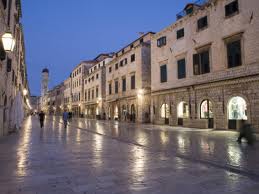

Stradun, also known as Placa, is the iconic main pedestrian street running through the heart of Dubrovnik's UNESCO-listed Old Town in Croatia. Stretching approximately 300 meters from east to west, it connects the western Pile Gate (Vrata od Pila) to the eastern Ploče Gate (Vrata od Ploča), serving as the vibrant central artery of the historic city. Paved with polished limestone that gleams underfoot due to centuries of wear, Stradun is more than just a thoroughfare—it's a lively promenade lined with shops, cafes, restaurants, and historic buildings, blending medieval charm with modern tourism. Often described as the "soul of Dubrovnik," it encapsulates the city's rich heritage, architectural harmony, and social energy, drawing millions of visitors annually who stroll its length to soak in the atmosphere of terracotta rooftops, ancient walls, and the Adriatic Sea beyond. The street is also famous for its Small and Great Onofrio Fountain.
The origins of Stradun trace back to the 11th-12th centuries when
Dubrovnik (then known as Ragusa) was developing as a maritime republic.
Originally, the site was a marshy channel or shallow sea strait
separating the Roman settlement of Ragusa on the southern rocky
peninsula from the Slavic forest settlement of Dubrava to the north.
This natural divide was filled in during the 11th century, creating a
unified urban space that evolved into the city's primary street by the
13th century. The street was officially paved with limestone slabs in
1468, enhancing its functionality as a commercial and social hub.
A
defining moment in Stradun's history was the catastrophic earthquake of
1667, which leveled much of Dubrovnik and ignited a massive fire that
destroyed many buildings along the street. In the aftermath, the
Republic of Ragusa implemented strict building regulations to rebuild in
a more uniform and fire-resistant manner, shaping the street's current
appearance. Prior to this, the architecture was eclectic, with varied
house designs featuring arcades and ornate carvings. The reconstruction
emphasized practicality and symmetry, resulting in the standardized
facades seen today.
More recently, Stradun endured damage from mortar
shelling during the Siege of Dubrovnik in the 1991-1992 Croatian War of
Independence, part of the Yugoslav Wars. Repairs were swiftly undertaken
to restore its pristine condition, preserving its role as a symbol of
the city's resilience. Throughout its history, Stradun has witnessed
Dubrovnik's golden age as a trading powerhouse, rivaling Venice, and has
been a stage for diplomatic processions, markets, and daily life.
Stradun exemplifies a harmonious blend of Gothic, Renaissance, and
Baroque influences, refined through post-1667 reconstructions. The
street itself is wide and straight, measuring about 300 meters long and
up to 12 meters across in places, with a gentle slope from west to east.
Its defining feature is the smooth, white limestone pavement, which has
developed a mirror-like sheen from countless footsteps over the
centuries—a phenomenon locals attribute to the "polishing" effect of
history.
The buildings lining both sides adhere to a regulated
17th-century design mandated after the earthquake: ground floors house
shops with a characteristic "knee" or semicircular arched opening that
serves as both door and window, often used historically as a counter for
displaying goods. Behind these are storage rooms accessible from back
alleys. Upper floors include living quarters on the first level,
additional rooms on the second, and attic kitchens designed to contain
potential fires. This uniform style creates a sense of architectural
cohesion, with facades featuring stone construction, green shutters, and
subtle decorative elements like cornices and arches. The worn
cobblestones add texture and character, making the street slippery when
wet but enhancing its photogenic appeal.
Stradun is dotted with historic landmarks that punctuate its length,
many dating back centuries and contributing to Dubrovnik's UNESCO
status.
Onofrio's Fountains: At the western end near Pile Gate
stands the Large Onofrio's Fountain (1438), a Renaissance masterpiece by
Onofrio della Cava, featuring 16 carved masks spouting water. At the
eastern end is the smaller counterpart, the Small Onofrio's Fountain,
providing fresh water to locals and visitors alike.
Sponza Palace:
Located midway, this 16th-century Gothic-Renaissance building houses
Dubrovnik's historical archives and features an elegant atrium used for
events.
Clock Tower and Bell Tower: At the eastern end, the
15th-century Clock Tower (Luža Tower) looms with its green-domed roof
and bronze figures that strike the hours. Nearby is the Dubrovnik Bell
Tower, adding to the skyline.
Orlando's Column: A medieval stone
column in Luža Square at the east, symbolizing the city's independence
and used historically for public announcements.
Franciscan Monastery:
At the western end, its bell tower complements the street's symmetry,
and the monastery itself houses one of Europe's oldest pharmacies.
These sites make Stradun a self-contained open-air museum, with side
streets branching off to reveal more hidden gems like churches and
palaces.
Culturally, Stradun is the epicenter of Dubrovnik's social and
festive life. It hosts the annual Feast of Saint Blaise on February 3,
featuring elaborate processions with participants in traditional
costumes parading relics of the city's patron saint. The street buzzes
with open-air concerts, theater performances, art exhibitions, and
summer festivals, transforming it into a stage for classical music and
cultural events. Locals engage in "điravanje," a leisurely stroll for
people-watching, chatting, and romance, a tradition that has sparked
countless love stories and even post-wedding walks. New Year's Eve
celebrations and occasional high-profile events, like the 2010 tennis
exhibition between Goran Ivanišević and John McEnroe, highlight its role
as a communal gathering spot.
In modern times, Stradun thrives as a
tourist magnet, offering boutique shopping for souvenirs, jewelry, and
fashion, alongside dining options from casual gelaterias to upscale
Croatian cuisine. Its fame has been amplified by appearances in media,
including as a filming location for Game of Thrones (representing
streets in King's Landing), boosting visitor numbers. However, this
popularity brings challenges like overcrowding, prompting tips for early
or late visits and comfortable footwear. Ultimately, Stradun embodies
Dubrovnik's enduring spirit—a timeless blend of history, community, and
allure that continues to captivate.